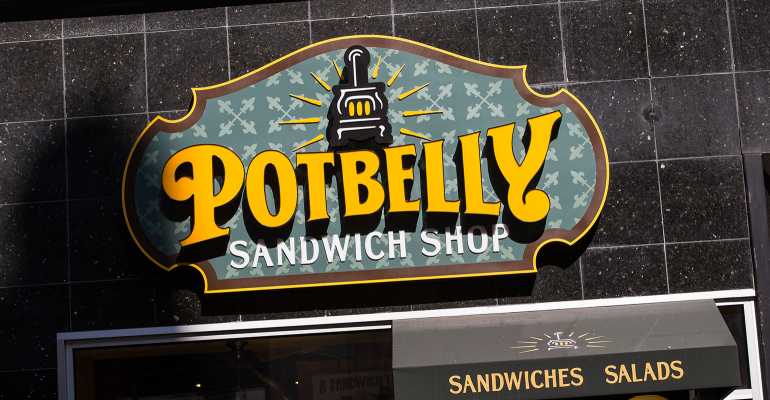The sandwich category is predicted to expand at a compound annual growth rate of nearly 7% through 2028, according to research from The Insight Partners. Potbelly anticipates having a larger share of that category than it’s had in the past and the company is well on its way to bring that goal to fruition – gaining share and traffic in an industry otherwise stagnant or declining.
This is according to CEO Bob Wright and CFO and chief strategy officer Steve Cirulis, who presented this week at the Stephens Annual Investment Conference. The presentation came on the heels of the 425-unit chain’s third quarter earnings, which included topline improvement and 8% same-store sales growth.
“We’re excited about the trends we’re operating under. We continue to see strong same-store sales growth. Traffic is really the big story for Potbelly,” Wright said, adding that more than half of the company’s same-store sales growth this year have come from traffic growth. “Not only are we growing traffic but when you compare us to the fast casual segment, as a category it is flat to negative. So, we’re up in sales, we’re growing traffic and we’re stealing share.”
How Potbelly is doing so is through a multi-layered approach that began in 2020, when the company brought Wright on board from Wendy’s and Cirulis on board from Panera. The then-new leadership team put into place a five-pillar strategy aimed at turning around sales and unit count declines and growing again. The pillars were straightforward, focusing on food, people, traffic growth, digital-driven awareness, and franchise development.
Q3 was yet another example of this years-long work coming to fruition, Wright said. To put a finer point on it, a year ago, shop-level margins were at 10.6%, which was an expansion of 190 basis points over 2021. This year’s Q3 saw shop-level margins at 14.6%, an increase of 400 basis points year-over-year. The goal is to get to 16% and executives are optimistic that will happen in the new year given the company’s current trajectory.
“Since we started working together in the summer of 2020, we formulated our five-pillar strategy … We’re still leveraging that same five-pillar strategy and the unifying objectives we started with – traffic driven profitability – we’ve added unit growth to go with it, continue to serve us very well,” Wright said.
As part of the growth piece, the company launched a franchise growth acceleration initiative in 2022, focused on a 10% annual new unit growth rate by next year. Currently, 150 units are under contract and, just this week, the company signed a deal in Washington state that includes taking on ownership of nine existing company units and the development of another 13 throughout the next eight years. The company’s long-term goal is to grow to 2,000 units, of which about 85% will be franchised. As Wright said, the company has “white space out the wazoo.”
“A 425-unit chain in 32 states … Usually a brand that size will be a super regional trying to prove it can grow. For us, it’s already proven, we just haven’t penetrated those markets,” he said.
And, with healthier four-wall economics, there won’t be a lot of complexity executing on the company’s aspirations, Cirulis said.
“This is not a high wire act. We have a lot of sight into what we need to do – the brand and food is there. With all that white space in front of us, the playbook is straightforward,” he said. “Once you build model that works, you want to replicate as quickly and far as you can. The other piece of it is the market opportunity. The pandemic wasn’t kind to everyone, and many restaurants failed. That’s a market opportunity for us, but you’ve got to act quickly. Combine healthy four-wall economics with new growth opportunity, all those things work for us.”
Though the company’s growth will come primarily through franchising, Potbelly will maintain some company-owned units and restructured its company unit PnL to reflect a franchisee’s.
“Franchisees are really comforted when they know you have to eat your own dog food. We have to live with those same decisions,” Wright said.
The company has also ramped up its focus on marketing and digital. On the digital side, Potbelly’s mix is now around 36% – a majority of which is coming through its owned channels.
“A lot of that traffic work we’re talking about we believe we’re driving because of what we’re doing with our marketing and more specifically our digital marketing efforts,” Wright said.
Wright also outlines the potential for Potbelly’s marketing strategy, which is leveraging the brand’s 46-year history and distinctiveness. The company hasn’t historically spent much on marketing, he said, but that is changing behind a 3% marketing spend budget that includes franchisee contributions. The investment has allowed Potbelly to reinvest in its digital assets and build the brand, and it’s been a boon to the topline.
“There’s more gas in the tank,” Wright said, noting that 3% is below industry average. Marketing is just one of the gaps the company is filling. Other gaps include operational updates with things like labor guides, training systems, and customer experience measurements.
“All of those things that create a strong restaurant company out of a great brand,” Wright said. “Sure, there are a lot of sub shops out there, but we are a fast casual restaurant that has a sandwich-based menu. But we also have great salads, we have amazing cookies, soups that are out of this world. And, we have special touches of quality. It’s that stuff that drew me to the brand.”
Contact Alicia Kelso at [email protected]

